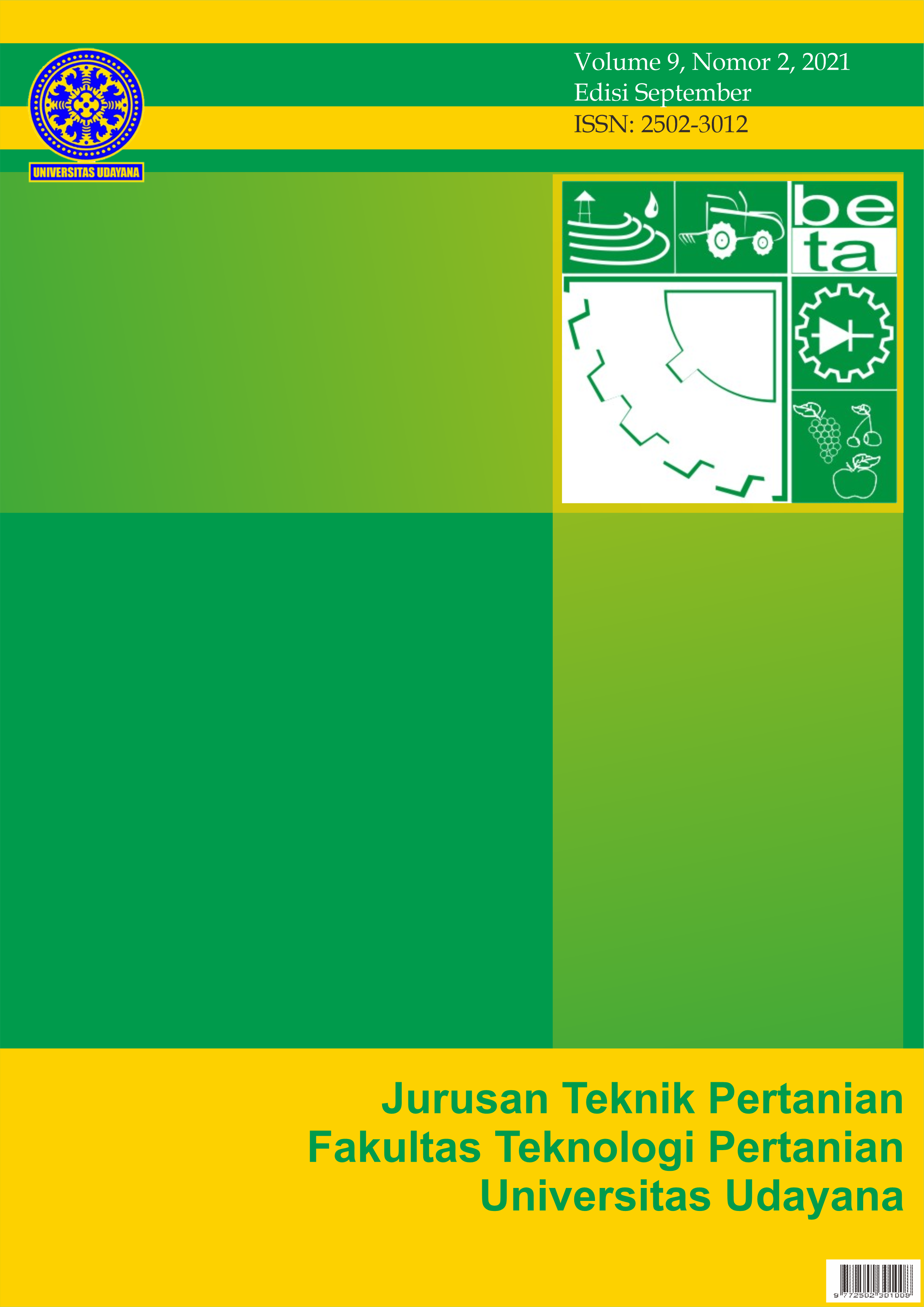Model Sistem Dinamik Stok Beras untuk Mendukung Ketahanan Pangan Provinsi Bali
Abstract
ABSTRAK
Kapasitas produksi beras yang terbatas dan konsumsi beras yang meningkat membuat kondisi rawan pangan berupa stok beras yang tidak mencukupi menjadi tidak terelakkan. Kompleksitas permasalahan beras di Provinsi Bali tidak hanya terkait dengan pemenuhan kebutuhan masyarakat lokal tetapi juga bagi wisatawan. Penelitian ini bertujuan untuk menganalisis dinamika hubungan sebab akibat dari variabel-variabel yang mempengaruhi keadaan produksi, konsumsi, dan stok beras di Provinsi Bali dengan menggunakan pendekatan sistem dan penerapan teknik pemodelan sistem dinamik. Dalam penelitian ini dibuat Causal Loop Diagram (CLD) dari sistem stok beras berdasarkan keterkaitan antara sub sistem produksi, sub sistem konsumsi dan sub sistem cadangan beras pemerintah yang melibatkan hubungan 24 variabel untuk menghasilkan output model berupa proyeksi stok beras di Provinsi Bali periode 2021-2030. Validasi hasil simulasi terhadap data aktual pada model dengan menggunakan metode RMSPE menunjukkan nilai 4,7062% (<5%), hal ini berarti model dikatakan sangat valid. Hasil simulasi model berdasarkan kondisi existing (skenario 0) menunjukkan bahwa stok beras mulai menurun sejak tahun 2018 dengan rata-rata laju penurunan sebesar 19,76% / tahun. Defisit stok beras mulai terjadi pada tahun 2026 sebesar 36.458 ton dan berlanjut pada tahun 2030 sebesar 448.162 ton. Kondisi tersebut dapat teratasi apabila Pemerintah Provinsi Bali melaksanakan kebijakan yang efektif dengan pilihan kebijakan peningkatan produktivitas padi dengan target minimal 6.7148 ton/hektar ((skenario 1 optimis) dan atau peningkatan intensitas tanam dengan target minimal 2.0622 (skenario 3 optimis).
ABSTRACT
Limited rice production capacity and increased rice consumption make food insecurity conditions in terms of insufficient rice stocks inevitable. The complexity of rice problems in Bali is not only related to fulfillment for local residents but also for tourists. This study aims to analyze the dynamics of the causal-loop relationship of variables that affect the state of production, consumption, and rice stock in the Bali Province using a systems approach and the application of dynamic system modeling techniques. In this study the Causal-Loop Diagram (CLD) of the rice stock system is formulated on the basis of the interrelationship of the production sub-system, the consumption sub-system and the government rice reserve sub-system which involves the relationship of 24 variables to produce a model output that is the projected rice stock in Bali for the period of 2021-2030. Validation of the simulation results against the actual data in the model using the RMSPE method shows a value of 4,7062% (<5%), this means that the model is said to be very valid. Model simulation results based on existing conditions (scenario 0), show that rice stocks begin to decline since 2018 with an average decline rate of 19,76% / year. The rice stock deficit begin in 2026 at 36.458 tons and continue in 2030 at 448.162 tons. This condition can be overcome if the provincial government of Bali implements an effective policy with a policy option that is to increase productivity of rice yields with a minimum target of 6,7148 ton/hectare ((scenario 1 optimistic) and or an increase in cropping intensity with a minimum target of 2,0622 (scenario 3 optimistic).
Downloads
References
Ardi, R., & Leisten, R. (2016). Assessing the role of informal sector in WEEE management systems: A System Dynamics approach. Waste Management, 57(1), 3–16. https://doi.org/10.1016/j.wasman.2015.11.038
Badan Pusat Statistik Provinsi Bali. (2011-2020). Provinsi Bali Dalam Angka. www.bali.bps.go.id. Diakses pada 28 Januari 2020
Besiou, M., Georgiadis, P., & Van Wassenhove, L. N. (2012). Official recycling and scavengers: Symbiotic or conflicting? European Journal of Operational Research, 218(2), 563–576. https://doi.org/10.1016/j.ejor.2011.11.030
Burchi, F., & De Muro, P. (2016). From food availability to nutritional capabilities: Advancing food security analysis. Food Policy, 60(2016), 10–19. https://doi.org/10.1016/j.foodpol.2015.03.008
FAO (Food and Agriculture Organization of the United Nations). (1996). Rome Declaration on World Food Security and World Food Summit Plan of Action. Adopted at the World Food Summit, November 13-17, Rome
Forrester, J. W. (1994). System Dynamics, Systems Thinking, and Soft OR. System Dynamics Review, 10(2), 245–256. https://doi.org/10.1093/clinchem/29.4.741
Forrester, J. W. (1999). System Dynamics: The Foundation Under System Thinking. Sloam School of Management Massachusetts Institute of Technology. Cambridge
Garside, A. K., & Asjari, H. Y. (2015). Simulasi Ketersediaan Beras di Jawa Timur. Jurnal Ilmiah Teknik Industri, 14(1), 47–58.
Kelton, W. D., R. P. Sadowski, dan N. B. Swets, 2010. Simulation with Arena. Edisi Kelima. McGraw Hill. New York
Kementerian Pertanian Republik Indonesia. (2017). Data Lima Tahun Terakhir. https://www.pertanian.go.id. Diakses pada tanggal 28 Januari 2020
Mahbubi, A. (2013). Model Dinamis Supply Chain Beras Berkelanjutan. Jurnal Manajemen Dan Agribisnis, 10(2), 81–89.
Nurliani, & Rosada, I. (2016). Rice-field Conversion and its Impact on Food Availability. Agriculture and Agricultural Science Procedia, 9(2016), 40–46. https://doi.org/10.1016/j.aaspro.2016.02.121
Nuryanti, S. (2018). Swasembada Beras Berkelanjutan: Dilema antara Stabilisasi Harga dan Distribusi Pendapatan. Forum Penelitian Agro Ekonomi, 35(1), 19–30. https://doi.org/10.21082/fae.v35n1.2017.19-30
Suharyanto, Mahaputra, K., Arya, N. N., & Rinaldi, J. (2016). Faktor Penentu Alih Fungsi Lahan Sawah di Tingkat Rumah Tangga Petani dan Wilayah di Provinsi Bali. Jurnal Pengkajian Dan Pengembangan Teknologi Pertanian, Badan Litbang Pertanian, 19(1), 9–22.
Ustriyana, I. N. G. (2015). Dynamic modeling of rice stock in Bali Province , Indonesia. European Journal of Business and Management, 7(26), 173–180.
Walls, H., Baker, P., Chirwa, E., & Hawkins, B. (2019). Food security, food safety & healthy nutrition: are they compatible? Global Food Security, 21(2019), 69–71. https://doi.org/10.1016/j.gfs.2019.05.005
Widhianthini, W. (2019). Implementasi Sistem Dinamik Dalam Bidang Pertanian. SOCA: Jurnal Sosial Ekonomi Pertanian, 12(2), 161. https://doi.org/10.24843/soca.2018.v12.i02.p03












 Jurnal BETA (Biosistem dan Teknik Pertanian)
Jurnal BETA (Biosistem dan Teknik Pertanian)


